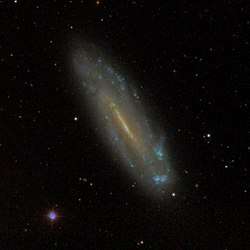NGC 4178
NGC 4178 is the New General Catalogue identifier for a barred spiral galaxy in the equatorial constellation of Virgo. It was discovered April 11, 1825 by English astronomer John Herschel.[7] Located some 43.8 million light years away,[4] this galaxy spans 2.3 × 0.4[1] arc minutes and is seen at a low angle, being inclined by 77° to the line of sight from the Earth.[5] The morphological classification of NGC 4178 is SB(rs)dm, indicating that it has a bar feature at the core, and, per the '(rs)', has traces of a ring-like structure surrounding the bar. The 'dm' suffix indicates the spiral arms are diffuse, broken, and irregular in appearance with no bulge at the nucleus.[2] This galaxy is a member of the Virgo Cluster, which is the richest nearby group of galaxies outside the Local Group and forms the core of the Virgo Supercluster.[5]
| NGC 4178 | |
|---|---|
 SDSS image of NGC 4178. | |
| Observation data (J2000 epoch) | |
| Constellation | Virgo |
| Right ascension | 12h 12m 46.443s[1] |
| Declination | +10° 51′ 57.59″[1] |
| Redshift | 0.001261 ± 0.000013[2] |
| Helio radial velocity | +377[3] km/s |
| Distance | 43.8 Mly (13.43 Mpc)[4] |
| Group or cluster | Virgo Cluster[5] |
| Characteristics | |
| Type | SB(rs)dm[2] |
| Size | 74,980 ly (estimated) |
| Apparent size (V) | 2.300′ × 0.414′[1] |
| Other designations | |
| 2MASX J12124644+1051575, LEDA 38943 , UGC 7215, UZC J121246.5+105206, Z 69−88, VCC 66 .[6] | |
The radio continuum emission along the galaxy's major axis is asymmetrical, being brighter in the southwestern part than in the northeast. But the overall radio surface brightness is on the low side.[8] In the mid-infrared range, the spectrum shows indications of high ionization levels usually associated with an active galactic nucleus.[9] However, optical observations show no signs of an active nucleus, which may just mean it is heavily obscured. Indeed, the amount of ionized matter appears to increase near the core.[10] Although this galaxy lacks a bulge that could supply mass to a supermassive black hole, a large black hole was detected at the core by the Chandra X-ray Observatory in 2012. It is inferred to have a mass of around 104 to 105 times the mass of the Sun.[10] This makes it one of the lowest mass nuclear black holes known.[9]
In May, 1963, supernova SN 1963i was discovered in this galaxy by G. V. Zaytsheva at the Konkoly Observatory in Budapest.[11] It was suspected of being a Type Ia supernova eruption, but this remains unconfirmed.[12]
References
- Skrutskie, M. F.; et al. (February 2006), "The Two Micron All Sky Survey (2MASS)", Astrophysical Journal, 131 (2): 1163–1183, Bibcode:2006AJ....131.1163S, doi:10.1086/498708.
- de Vaucouleurs, G.; et al. (1991), "Third reference catalogue of bright galaxies, version 9", The Astronomical Journal, 108: 2128, Bibcode:1994AJ....108.2128C, doi:10.1086/117225, retrieved 2015-11-25.
- Crook, Aidan C.; et al. (February 2007), "Groups of Galaxies in the Two Micron All Sky Redshift Survey", The Astrophysical Journal, 655 (2): 790–813, arXiv:astro-ph/0610732, Bibcode:2007ApJ...655..790C, doi:10.1086/510201.
- Tully, R. Brent; et al. (October 2013), "Cosmicflows-2: The Data", The Astronomical Journal, 146 (4): 25, arXiv:1307.7213, Bibcode:2013AJ....146...86T, doi:10.1088/0004-6256/146/4/86, 86.
- Tully, R. B.; Fisher, J. R. (February 1977), "A new method of determining distances to galaxies", Astronomy and Astrophysics, 54 (3): 661–673, Bibcode:1977A&A....54..661T.
- "NGC 4178". SIMBAD. Centre de données astronomiques de Strasbourg. Retrieved 2015-12-03.
- Seligman, Courtney, "NGC 4178", Celestial Atlas, retrieved 2015-11-04.
- Vollmer, B.; et al. (May 2013), "Large-scale radio continuum properties of 19 Virgo cluster galaxies. The influence of tidal interactions, ram pressure stripping, and accreting gas envelopes", Astronomy & Astrophysics, 553: 36, arXiv:1304.1279, Bibcode:2013A&A...553A.116V, doi:10.1051/0004-6361/201321163, A116.
- Secrest, N. J.; et al. (July 2012), "The Chandra View of NGC 4178: The Lowest Mass Black Hole in a Bulgeless Disk Galaxy?", The Astrophysical Journal, 753 (1): 7, arXiv:1205.0230, Bibcode:2012ApJ...753...38S, doi:10.1088/0004-637X/753/1/38, 38.
- Secrest, N. J.; et al. (November 2013), "A Multi-wavelength Analysis of NGC 4178: A Bulgeless Galaxy with an Active Galactic Nucleus", The Astrophysical Journal, 777 (2): 6, arXiv:1308.5270, Bibcode:2013ApJ...777..139S, doi:10.1088/0004-637X/777/2/139, 139.
- Kukarkin, B. V. (May 1963), "Supernova in NGC 4178", Information Bulletin on Variable Stars, 28: 1, Bibcode:1963IBVS...28....1K.
- Lanoix, P. (March 1998), "HIPPARCOS calibration of the peak brightness of four SNe IA and the value of H_0", Astronomy and Astrophysics, 331: 421–427, arXiv:astro-ph/9712137, Bibcode:1998A&A...331..421L.
External links

- NGC 4178 on WikiSky: DSS2, SDSS, GALEX, IRAS, Hydrogen α, X-Ray, Astrophoto, Sky Map, Articles and images